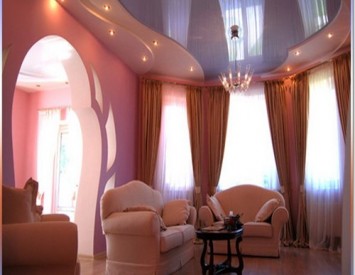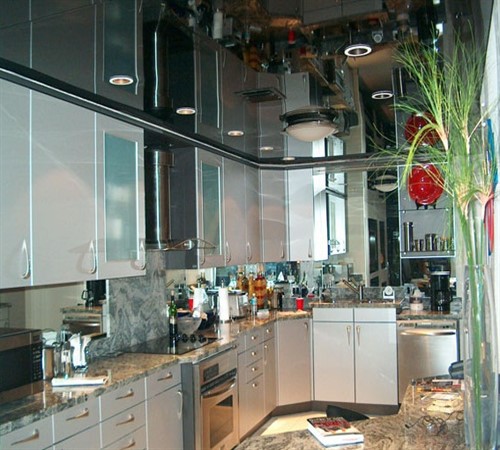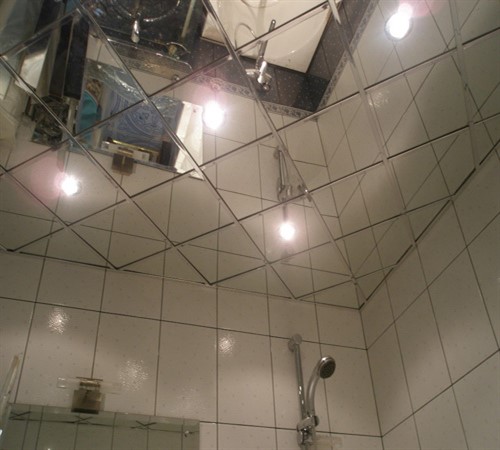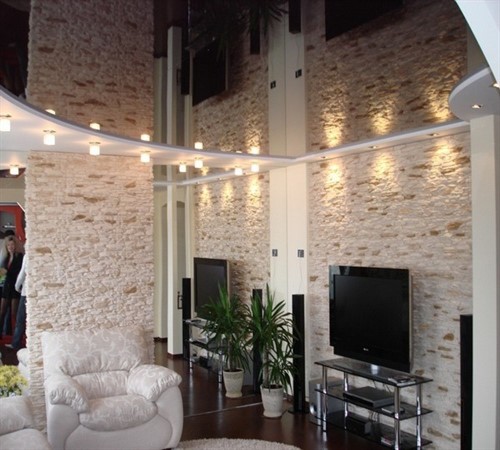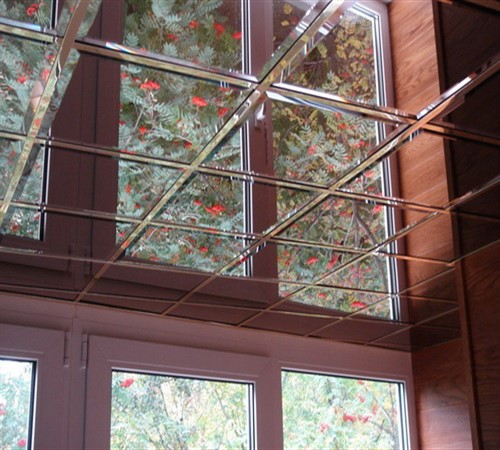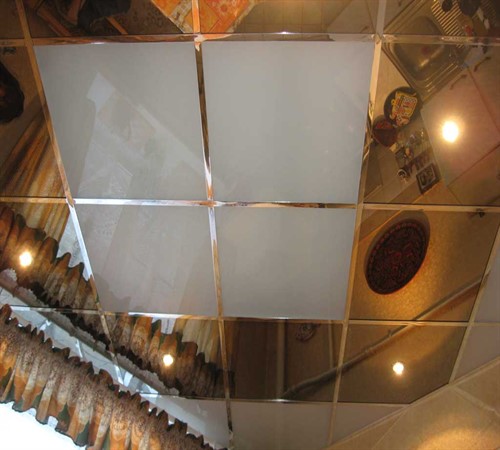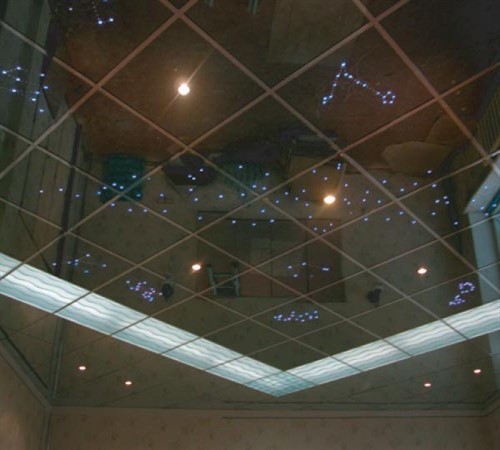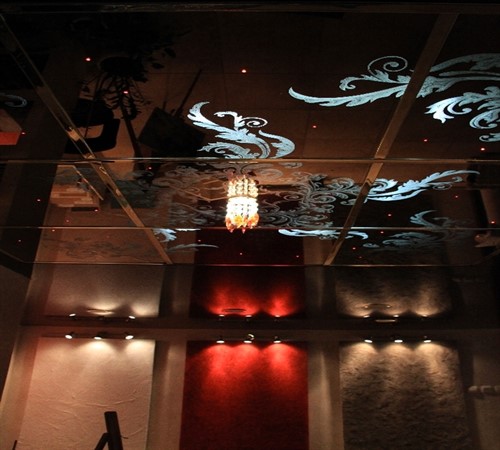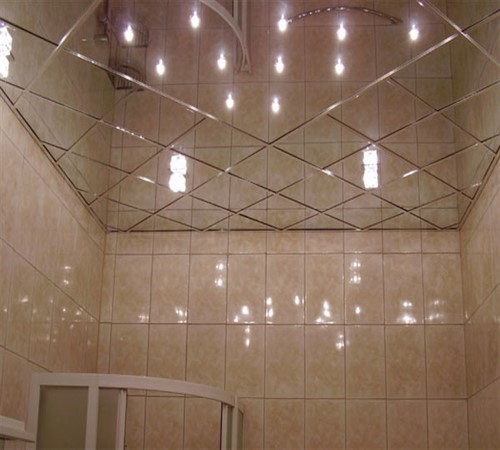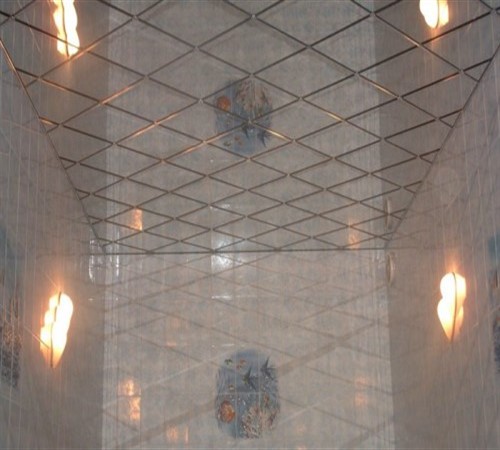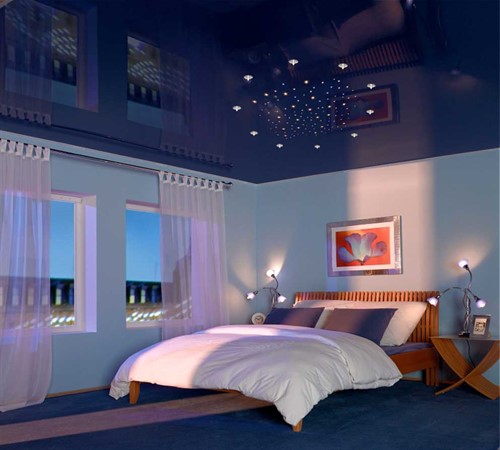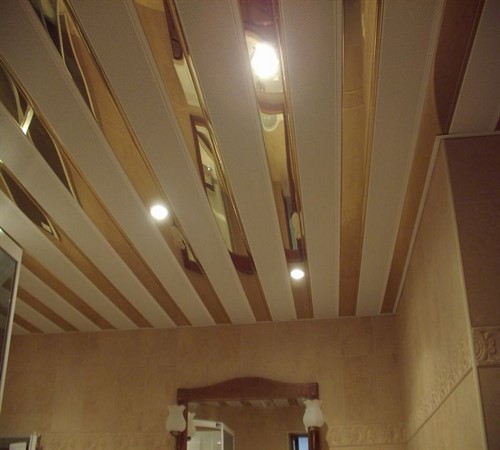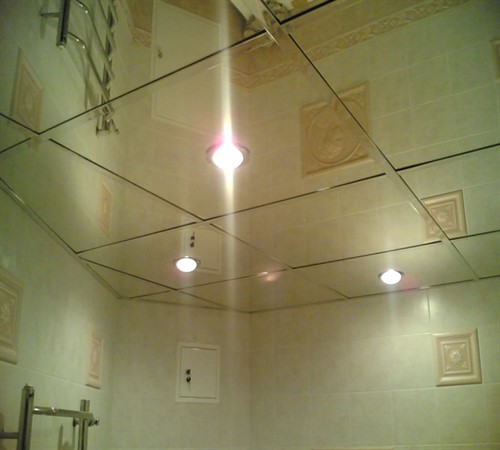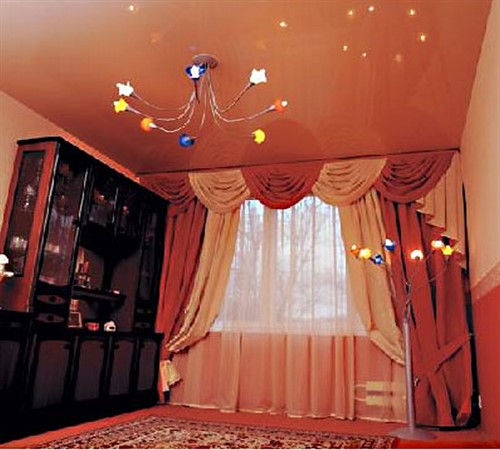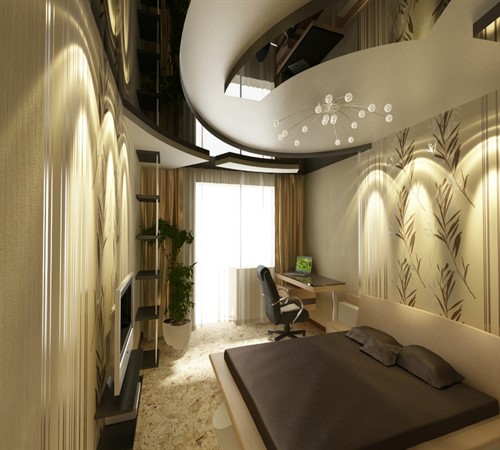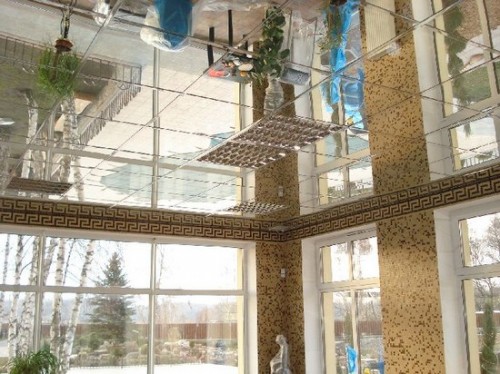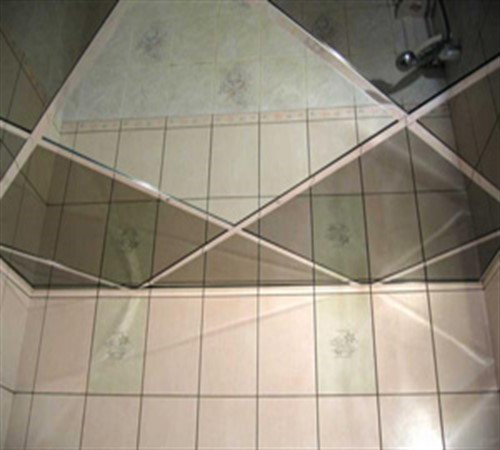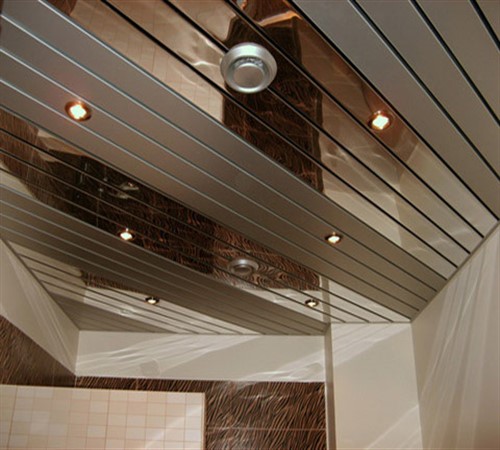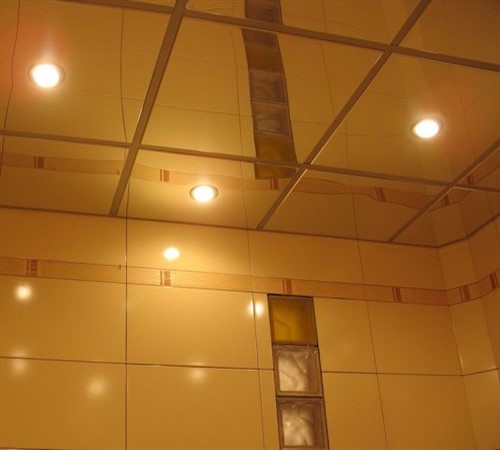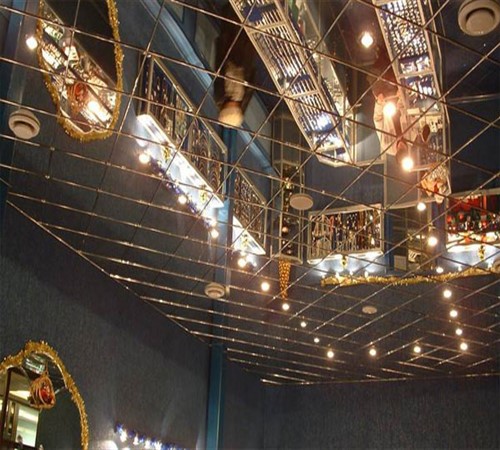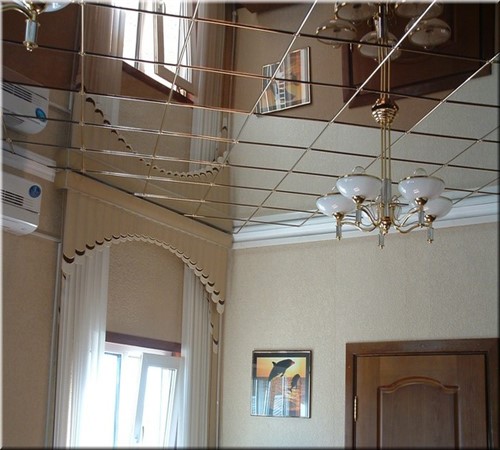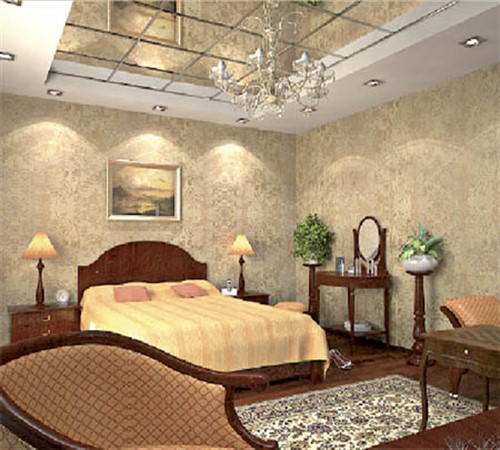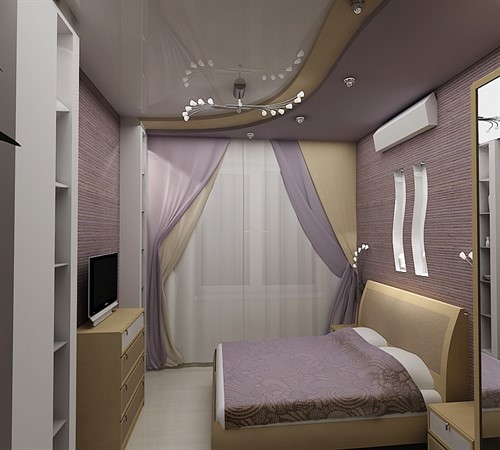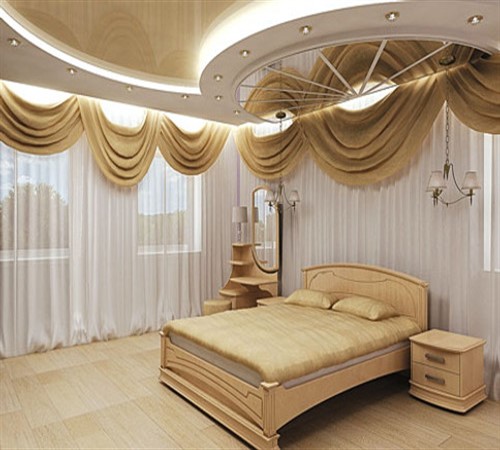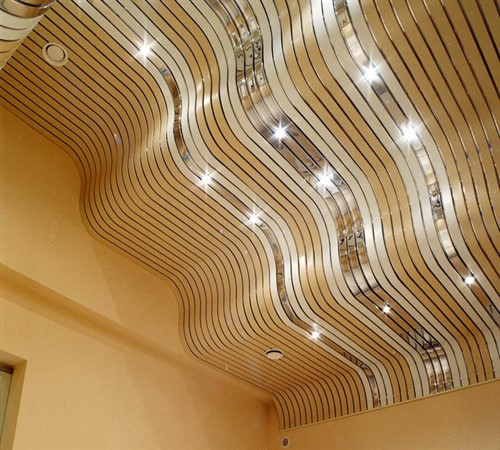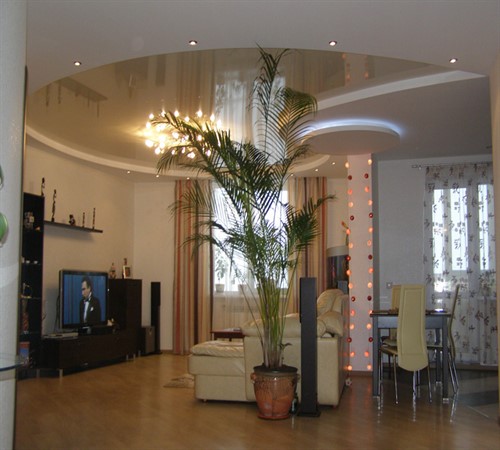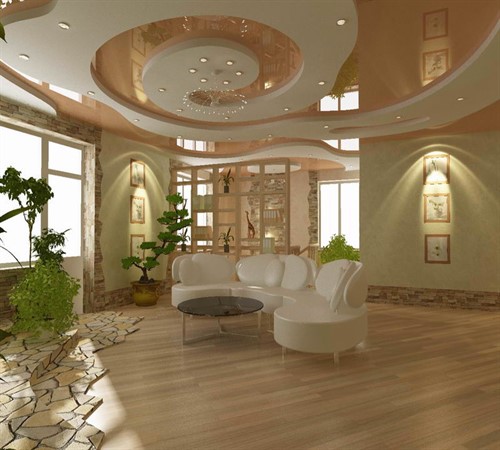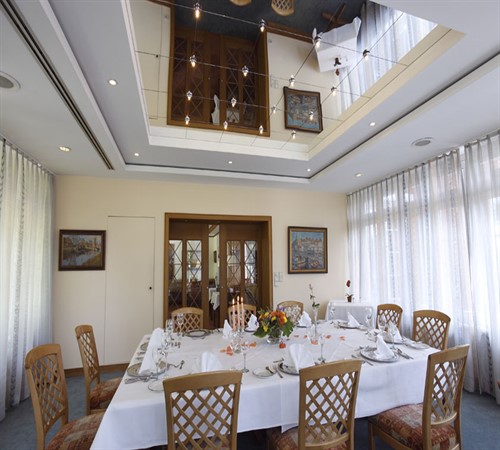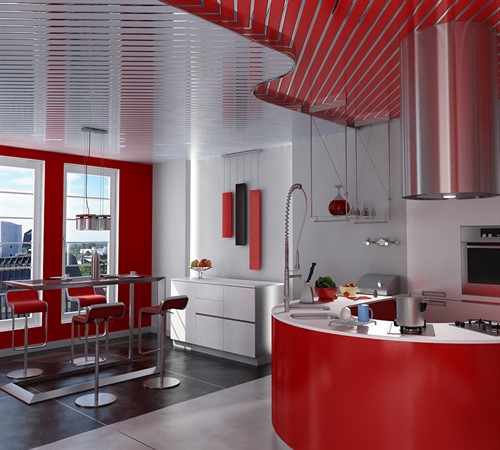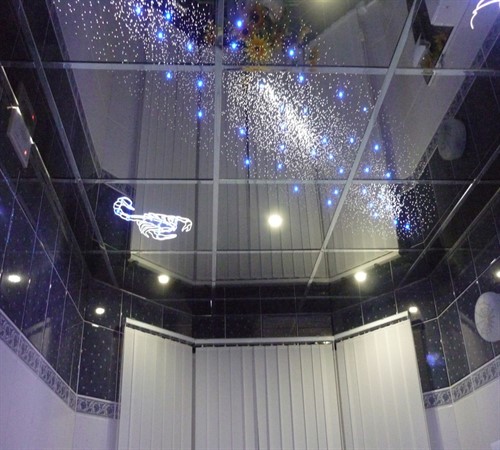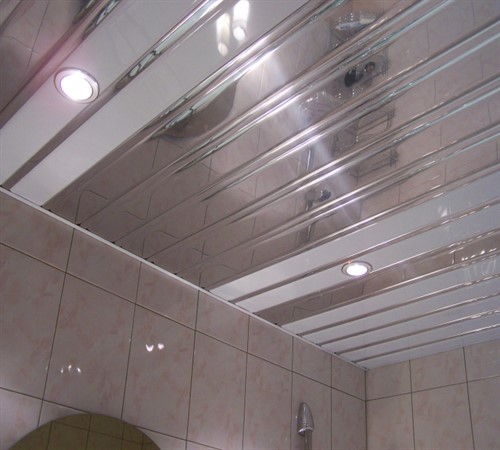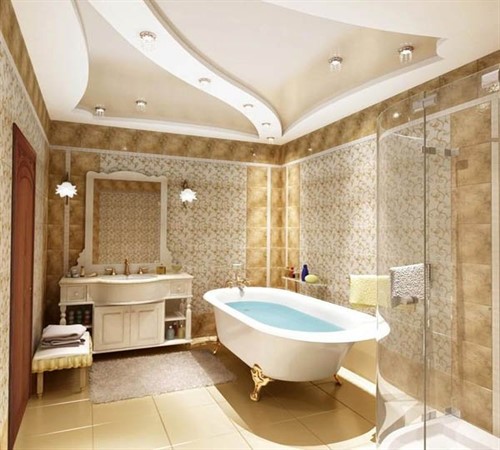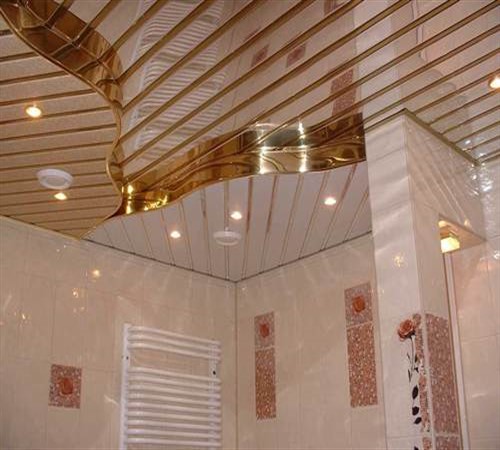Recently, mirror ceilings have become quite extensive spread that harmoniously fit into any interior style, since they are made not only from pieces of a traditional mirror, but also from aluminum, polystyrene, PVC and other materials. Often, the decoration and finish of the ceiling is made by combining mirror ceilings with other finishing materials (for example, with drywall), as a result of which very interesting compositions are obtained.
Content
Advantages and disadvantages of mirror ceilings
The spectacity and decorativeness of mirror ceilings are far from the main factors of the manifestation of such interest in them in the decoration of the premises, because the manufacture of mirror ceilings from various materials determines their features and disadvantages that allow you to choose the ceiling regarding its operating conditions and available funds. However, the advantages of all varieties of mirror ceilings come down to the following:
- excellent wear resistance;
- resistance to sunlight;
- resistance to mold, fungus;
- installation speed;
- unpretentiousness and ease of care;
- the ability to replace the damaged element without dismantling the structure;
- durability.
At the same time, inherent, from the advantages of mirror ceilings, partly defects such as:
- the ability to attract dust;
- excellent visibility of even small pollution;
- when using the suspended method of fastening, panels or tiles are located either diagonally or directly.
The disadvantages of the general plan seem quite insignificant against the background of all advantages. However, each type of mirror ceiling complements the list of common advantages or disadvantages, largely determining the operating conditions and the place of application of a particular mirror ceiling.
Types of mirror ceilings, their features
At the moment, there are several varieties of mirror ceilings that have certain features of installation, care, accommodation.
A solid mirror canvas
The whole canvas on the ceiling looks not only very impressive, stylish, attractive, but also gives the surrounding interior unsurpassed luxury. However, the installation and subsequent operation of such a ceiling causes a lot of difficulties associated with the following features:
- the fragility of the material requires special skills and certain qualifications of workers during installation;
- it is quite difficult to introduce, unfold and lift a whole canvas to the ceiling, especially large sizes;
- the severity of the whole canvas, even with careful installation, will eventually affect the mount, causing the danger of collapse to the floor.
In addition, the use of an integral canvas, in relation to other types of mirror ceilings, is economically irrational due to a rather high cost.
Mirror tiles
Mirror tiles appear as a result of dividing the whole mirror canvas into separate segments of square, rhomboid, hexagonal shape. Similar to break the mirrors into certain segments, the effect of an extraordinary, “cut” image is achieved, so that the geometry of the entire room changes.
The variety of shapes, shades, sizes of tiles opens up wide opportunities for the flight of design thought. In this case, the outer side of mirror tiles, in addition to various shades, happens:
- glossy;
- matte;
- tinted;
- with a pattern of any complexity;
- with fatset, decoratively mowed faces. The luminous flux, refracting on the edge, illuminates the room with rainbow shades.
Features of mirror tiles:
- Installation and transportation of tiles require maximum accuracy, since the surface is easily scratched.
- Poor ventilation of the room over time will cause darkening of the mirror surface.
Mirror rack ceilings
The rack ceilings are represented by aluminum, less often with steel panels covered with reflective spraying, so the reflection is somewhat distorted. In relation to mirror tiles, the reed panels have low weight and quite high strength, which greatly facilitates the installation. However, before the acquisition and installation of the rack ceiling, the following features should be taken into account:
- The thickness of high -quality panels should be at least 0.5 cm, since too thin rails are subject to deformation during operation, and when installing, small dents remain on them.
- Installation is carried out using the suspension system, so when replacing the damaged element, there is no need to dismantle the whole structure.
- The ceiling decor of the mirror rail is a rather time -consuming process. In addition, condensate manifests itself on the ceiling in the form of spots, which requires constant care.
Mirror plastic panels
Mirror plastic panels are made of polystyrene, on top of which a reflective film is applied. The surface of the panels has good shock resistance and can be smooth or ribbed. The fastening of polystyrene mirror panels on the ceiling is carried out by means of the adhesive layer, although PVA is used in its absence. However, such plates are inherent in their distinguishing features:
- Polystyrene slabs that do not have a moisture -proof coating cannot be used to finish the ceiling in the kitchen, bathroom, so in the store it is worthwhile to ask about the presence of the necessary coating.
- Before gluing panels sold in rolls, it is necessary to straighten the canvas under the load and withstand in a warm room for a day.
- It is necessary to have a flat surface, although the flexibility of the material will contribute to the concealment of minor defects of the ceiling.
- Powerful lamps may well melt the ceiling, so you should pay attention to the manufacturer’s information about the safe power of the lamps for such a ceiling.
In general, mirror polystyrene slabs, even processed by a moisture -proof composition, is not recommended to use the ceiling in the bathroom. The condensate of the couple, settling on the ceiling, requires constant care of panels, and as a result of constant wiping the surface on the film, scratches appear on the film, which will soon spoil the original type of mirror ceiling.
Stretch ceilings
The stretch fabric - from previous species differs in the blur of the reflected outlines of the interior, since a polyvinyl chloride film is used, which has a glossy surface, due to which a reflective effect occurs. However, the mirror stretch ceiling, the photo of which is presented below, is practically not inferior to mirror reflection, while the cost of a stretch ceiling costs somewhat cheaper than other varieties of mirror ceilings.
In addition, when using suspended ceilings, there is no need to equalize the surface, and in wet rooms such a ceiling prevent the collection of condensate, significantly facilitating care.
Methods of fastening the mirror ceiling
Installation of tiles to the base is carried out using:
- Special glue designed for mirrors. Glueing the tiles to the base, which has even minor protrusions, will lead to poor adhesion of materials and broken reflection, spoiling all aesthetics. For this reason, it is necessary to carefully remove all the paint, plaster and other contaminants from the ceiling. To obtain a perfectly flat surface, it is advisable to close the ceiling with a moisture -resistant drywall, or plywood and then proceed to the direct attachment of the tiles.
- Self -tapping screws. There are panels with ready -made holes and without them. In some models of ceiling mirror tiles, cuts on the faces are provided, accelerating installation. When applying, drank neighboring tiles on top of each other, a self -tapping screw is screwed into the base. Thus, two tiles are simultaneously attached.
- Glue and screws. First, the tile is glued to the ceiling, and then fixed with self -tapping screws, forming a more reliable structure.
- The modular suspension system of increased strength, including the frame, guides and decorative rails for concealing inter -seams. In such a frame, it is easy to hide the wiring, ventilation holes.
Despite the variety of methods for attaching the panels to the ceiling, the mirror suspended ceiling occupies a leading position, since it has indisputable advantages, excluding the shortcomings of other fasteners.
Advantages of a suspended mirror ceiling:
- there is no need to prepare the base;
- lack of dust;
- ease of dismantling the structure;
- well -visible ceiling defects are perfectly visible;
- simplicity of replacing damaged elements;
- the ability to hide ventilation, wires;
- the possibility of building a multi -tiered structure.
However, the fastening of mirror ceilings through self -tapping screws, glue still remains widespread.
The role of mirror ceilings in the interior
The decoration of various objects of the interior, the walls of the room can no longer be hit, but it is quite possible for mirror ceilings, because the reflection of the totality of objects located in the zone of such a ceiling looks completely different, giving some mystery to the surrounding interior. In addition, mirror ceilings:
- will contribute to a visual increase in the space of the room;
- perfectly mask significant irregularities of the surface;
- are a source of additional lighting, since sunlight or light from lamps is perfectly reflected from the mirror surface and is evenly distributed throughout the room;
- any interior will be supplemented, thanks to a wide tint row, sizes and shape of the produced elements;
- allow you to install built -in lamps;
- thanks to the moisture -proof coating, it is widely used to decorate the ceilings in rooms with a high level of humidity;
- they allow you to choose the most suitable option regarding the style and financial side of the issue, in connection with the variety of models, options, as well as methods of attachment to the ceiling.
Options for using a mirror ceiling
The decorativeness of mirror ceilings and a combination with various materials allow you to build unique multi -tiered structures that affect indescribable beauty and sophistication.
In the bedroom
A place reserved for relaxation, sleep, do not overload the snow -white ceiling, which consists entirely of mirror tiles with a clear reflection.
In this case, the insert of mirror tiles into the drywall structure looks quite elegant and unobtrusive.
The most suitable option is a stretch mirror ceiling of muffled, calm shades.
Thanks to the multi -tier design of the ceiling with various inserts of mirror tiles and a stretch fabric, the bedroom will acquire a festive, romantic atmosphere.
A rather original view of the bedroom will betray the decor of the rack panels.
Thus, the mirror ceiling in the bedroom can significantly change the atmosphere of the environment.
In the living room
When choosing a mirror ceiling for the living room, it is quite possible to dwell on any option, surrendering only to your own preferences.
Of course, stretch mirror ceilings firmly settled in the modern market and are used to build any ceiling structures.
However, the mirror insert into the drywall structure looks no less attractive.
Mirror ceilings are easily combined with many materials, so you should not restrain your imagination. At the same time, the mirror ceilings, the photo of which is present in the article, may be a motivation for creating their own unique combination of various materials.
In the kitchen
The most lively place in the apartment is the kitchen. In the process of cooking steam, fat spray finds a barrier to spread in the form of a ceiling, so it is better not to use mirror tiles and rheal panels for the ceiling decor in the kitchen, since the spots are clearly visible on such materials and require constant care.
At the same time, the blur of reflection in stretch ceilings for the kitchen will, on the contrary, be an ideal solution.
Therefore, before choosing a mirror ceiling, you should initially think about the subsequent care of one or another type of ceiling.
In the bathroom
In view of the high cost, the most widespread was the mirror ceiling in the bathroom. A large role in this is played by a small area of \u200b\u200bboth relative funds and subsequent care of the ceiling.
The ceiling looks great in the bathroom:
- from mirror tiles;
- from aluminum rails;
- from PVC film;
- from a multi -tiered structure.
Thus, reflecting the property of mirror ceilings allows you to create miracles, visually turning a small room into a large one, while filling it with natural or artificial light as much as possible. The main thing is to choose the right mirror material, taking into account all its features.
